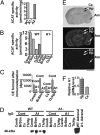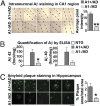ACAT1 gene ablation increases 24(S)-hydroxycholesterol content in the brain and ameliorates amyloid pathology in mice with AD
- PMID: 20133765
- PMCID: PMC2840286
- DOI: 10.1073/pnas.0913828107
ACAT1 gene ablation increases 24(S)-hydroxycholesterol content in the brain and ameliorates amyloid pathology in mice with AD
Abstract
Cholesterol metabolism has been implicated in the pathogenesis of several neurodegenerative diseases, including the abnormal accumulation of amyloid-beta, one of the pathological hallmarks of Alzheimer disease (AD). Acyl-CoA:cholesterol acyltransferases (ACAT1 and ACAT2) are two enzymes that convert free cholesterol to cholesteryl esters. ACAT inhibitors have recently emerged as promising drug candidates for AD therapy. However, how ACAT inhibitors act in the brain has so far remained unclear. Here we show that ACAT1 is the major functional isoenzyme in the mouse brain. ACAT1 gene ablation (A1-) in triple transgenic (i.e., 3XTg-AD) mice leads to more than 60% reduction in full-length human APPswe as well as its proteolytic fragments, and ameliorates cognitive deficits. At 4 months of age, A1- causes a 32% content increase in 24-hydroxycholesterol (24SOH), the major oxysterol in the brain. It also causes a 65% protein content decrease in HMG-CoA reductase (HMGR) and a 28% decrease in sterol synthesis rate in AD mouse brains. In hippocampal neurons, A1- causes an increase in the 24SOH synthesis rate; treating hippocampal neuronal cells with 24SOH causes rapid declines in hAPP and in HMGR protein levels. A model is provided to explain our findings: in neurons, A1- causes increases in cholesterol and 24SOH contents in the endoplasmic reticulum, which cause reductions in hAPP and HMGR protein contents and lead to amelioration of amyloid pathology. Our study supports the potential of ACAT1 as a therapeutic target for treating certain forms of AD.
Conflict of interest statement
The authors declare no conflict of interest.
Figures





Similar articles
-
Acyl-coenzyme A:cholesterol acyltransferase 1 blockage enhances autophagy in the neurons of triple transgenic Alzheimer's disease mouse and reduces human P301L-tau content at the presymptomatic stage.Neurobiol Aging. 2015 Jul;36(7):2248-2259. doi: 10.1016/j.neurobiolaging.2015.04.002. Epub 2015 Apr 7. Neurobiol Aging. 2015. PMID: 25930235 Free PMC article.
-
Acat1 knockdown gene therapy decreases amyloid-β in a mouse model of Alzheimer's disease.Mol Ther. 2013 Aug;21(8):1497-506. doi: 10.1038/mt.2013.118. Epub 2013 Jun 18. Mol Ther. 2013. PMID: 23774792 Free PMC article.
-
Silencing the ACAT1 Gene in Human SH-SY5Y Neuroblastoma Cells Inhibits the Expression of Cyclo-Oxygenase 2 (COX2) and Reduces β-Amyloid-Induced Toxicity Due to Activation of Protein Kinase C (PKC) and ERK.Med Sci Monit. 2018 Dec 12;24:9007-9018. doi: 10.12659/MSM.912862. Med Sci Monit. 2018. PMID: 30541014 Free PMC article.
-
ACAT1 as a Therapeutic Target and its Genetic Relationship with Alzheimer's Disease.Curr Alzheimer Res. 2019;16(8):699-709. doi: 10.2174/1567205016666190823125245. Curr Alzheimer Res. 2019. PMID: 31441726 Review.
-
ACAT1/SOAT1 as a therapeutic target for Alzheimer's disease.Future Med Chem. 2015;7(18):2451-67. doi: 10.4155/fmc.15.161. Epub 2015 Dec 15. Future Med Chem. 2015. PMID: 26669800 Free PMC article. Review.
Cited by
-
Palmitoylation of amyloid precursor protein regulates amyloidogenic processing in lipid rafts.J Neurosci. 2013 Jul 3;33(27):11169-83. doi: 10.1523/JNEUROSCI.4704-12.2013. J Neurosci. 2013. PMID: 23825420 Free PMC article.
-
The Rationale for Insulin Therapy in Alzheimer's Disease.Molecules. 2016 May 26;21(6):689. doi: 10.3390/molecules21060689. Molecules. 2016. PMID: 27240327 Free PMC article. Review.
-
Relationship Between Genetic Variants of ACAT1 and APOE with the Susceptibility to Dementia (SADEM Study).Mol Neurobiol. 2021 Mar;58(3):905-912. doi: 10.1007/s12035-020-02162-3. Epub 2020 Oct 14. Mol Neurobiol. 2021. PMID: 33057949
-
Upregulated function of mitochondria-associated ER membranes in Alzheimer disease.EMBO J. 2012 Nov 5;31(21):4106-23. doi: 10.1038/emboj.2012.202. Epub 2012 Aug 14. EMBO J. 2012. PMID: 22892566 Free PMC article.
-
Characterization of Stealth Liposome-Based Nanoparticles Encapsulating the ACAT1/SOAT1 Inhibitor F26: Efficacy and Toxicity Studies In Vitro and in Wild-Type Mice.Int J Mol Sci. 2024 Aug 23;25(17):9151. doi: 10.3390/ijms25179151. Int J Mol Sci. 2024. PMID: 39273099 Free PMC article.
References
-
- Hardy J, Selkoe DJ. The amyloid hypothesis of Alzheimer’s disease: progress and problems on the road to therapeutics. Science. 2002;297:353–356. - PubMed
-
- Wolozin B. Cholesterol and the biology of Alzheimer’s disease. Neuron. 2004;41:7–10. - PubMed
-
- Wellington CL. Cholesterol at the crossroads: Alzheimer’s disease and lipid metabolism. Clin Genet. 2004;66:1–16. - PubMed
Publication types
MeSH terms
Substances
Grants and funding
LinkOut - more resources
Full Text Sources
Other Literature Sources
Medical
Molecular Biology Databases
Miscellaneous

